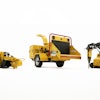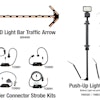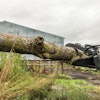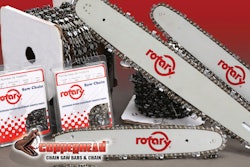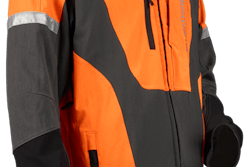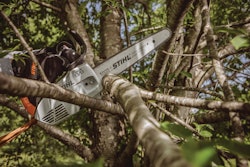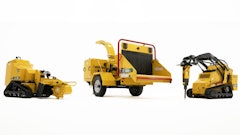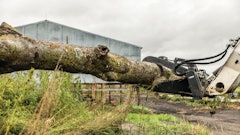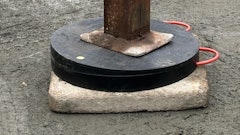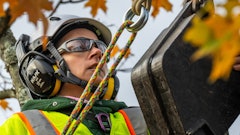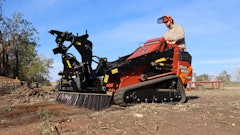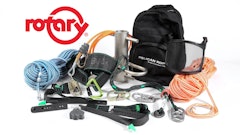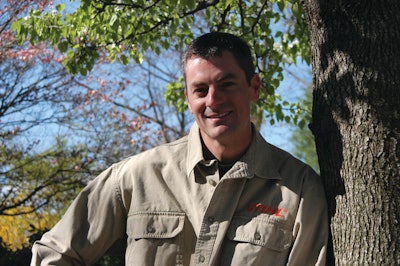
As a third-generation, certified arborist working with his family-owned Aspen Tree Expert Company in New Jersey, Mark Chisholm is a trusted source when it comes to tree care and chainsaw use. Here, he shares some tips for how to choose the right saw for the job and maintain it properly to get the best performance and ensure your safety.
The right saw for the job
For Chisholm, there are a few factors that fall into play when choosing a chainsaw. It has a lot to do with the task at hand, and the environment he’s cutting in.
“I'm a practicing arborist who does all applications of tree care, so I need a wide assortment of chainsaws to suit my needs,” says Chisholm. “I use the smaller chainsaws for any kind of pruning technique.”
When pruning trees of any size, Chisholm says the lighter the better. He personally chooses the top-handled Stihl MS 150 T C-E. He chooses the chainsaw for its light weight and narrow tip.
“I like it because it comes with a really narrow tipped chain,” shares Chisholm. “A bar with a thin chain means you can be real precise with a pruning cut. That is what we're after—moving like a surgeon with your turns.”
When moving beyond pruning to tree removal, Chisholm goes for more power. Adding power also adds weight.
“For removal, you need a little bit more power in the tree,” says Chisholm. “You need something that cuts quickly and really is a workhorse. We always try to pick the most powerful unit for the task.”
A high power-to-weight ratio is ultimately what wins Chisholm over with a chainsaw. “I like to go for the most power in the smallest package that I need for that specific job,” he says.
For a pole saw, the area where you are cutting calls the shots. The presence of power lines is definitely a deciding factor.
“If you're working around any kind of electrical conductors, you're going to want a pole saw that's made for that practice,” says Chisholm. “A pole made of foam-filled fiberglass pipe is meant to be used in that situation.”
Chisholm advises that if you aren’t challenged by power lines, go for an aluminum pole. He says the lightweight design of an aluminum, telescoping pole is your best option if you have the freedom to use one.
Eye on maintenance
As a professional arborist, Chisholm swears by taking good care of equipment from the start. To prevent downtime, he chooses to use high-quality oil and fuel, and keeps his eye on the chain for signs of wear.
“If you take good care of your machines, you are going to have less downtime and less repairs to be made,” says Chisholm. “Maintenance starts with the right quality oil and fuel.”
Chisholm uses commercial-quality test fuel, which carries a higher price that turns many users away despite its ability to save on maintenance. “Many people don't use test fuel because of how expensive it is,” says Chisholm. “You don't realize the cost down the road saved on maintenance issues from using cheaper fuel with more ethanol and other related issues.”
Conditions in the field and the type of cutting you are doing all play a role in the wear of your chain. Chisholm says the chain shouldn’t dull as quickly when working in the tree as it would on the ground in the presence of dirt stone and concrete. Keeping your chain sharp is the safest and best way to operate. If you notice just the slightest dulling of the chain, it’s time to sharpen. Waiting for the chain to get really dull increases your safety risk and the amount of time lost repairing the chain.
“When people run their saws with dull chains, it's not as safe,” warns Chisholm. “You're putting more pressure on the chain than you need to in order to try and make the cut.”
Taking the time out to actually sharpen the saw chain right when you start noticing it getting dull prevents further chain damage. “People don't realize that the more you run a dull saw, the more damage you are causing at a faster rate to the chain," explains Chisholm. "You’ll have to work that much harder to get it sharp again.”
Know your limits
The key to safety in tree care and removal, is knowing your limits. Consider your environment, the task and your level of training and experience when planning the equipment and approach you will use in tree care.
“If it's a sizable cut, it's safer to get up in the tree where you can cut in a comfortable position secured to the tree,” says Chisholm. “Anytime you can’t work safely from the ground, you really shouldn't get into a tree unless you’re trained to do so.”
To reduce the risk of injury, Chisholm suggests never cutting above your head as you run the risk of having a pieces fall on you from above. He says consider using a pole saw, but nothing is safer than being in the tree. Whatever you’re cutting, know what your strength and training permits.
“The people who stay safe out there are the ones who realize their limitations and stop before it’s dangerous,” says Chisholm. “The hard part is realizing when you should be doing something different.”

